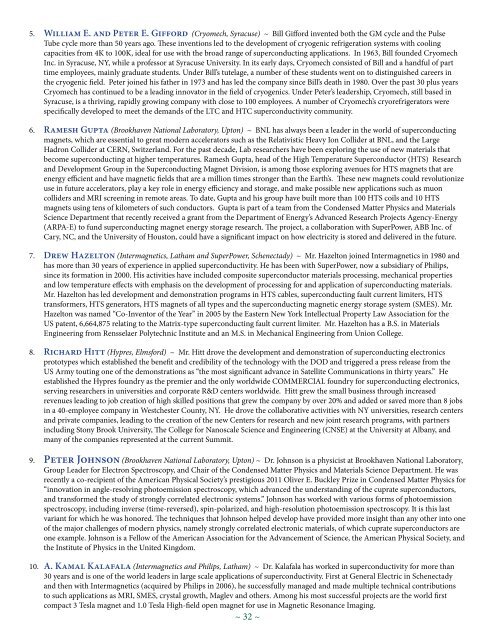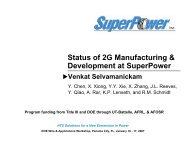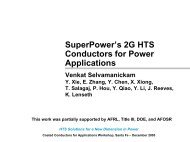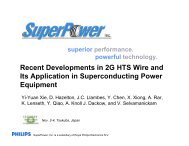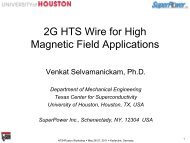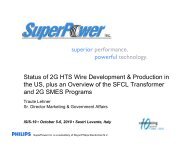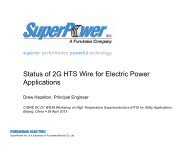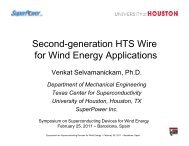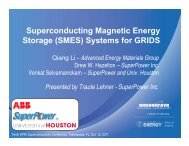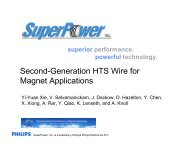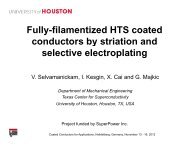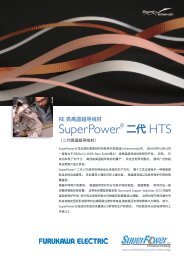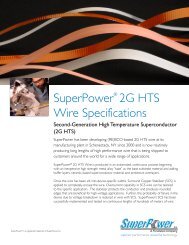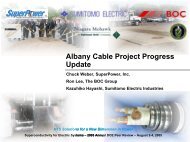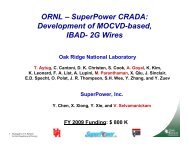New York State Leaders In Superconductivity... - SuperPower
New York State Leaders In Superconductivity... - SuperPower
New York State Leaders In Superconductivity... - SuperPower
Create successful ePaper yourself
Turn your PDF publications into a flip-book with our unique Google optimized e-Paper software.
5. William E. and Peter E. Gifford (Cryomech, Syracuse) ~ Bill Gifford invented both the GM cycle and the Pulse<br />
Tube cycle more than 50 years ago. These inventions led to the development of cryogenic refrigeration systems with cooling<br />
capacities from 4K to 100K, ideal for use with the broad range of superconducting applications. <strong>In</strong> 1963, Bill founded Cryomech<br />
<strong>In</strong>c. in Syracuse, NY, while a professor at Syracuse University. <strong>In</strong> its early days, Cryomech consisted of Bill and a handful of part<br />
time employees, mainly graduate students. Under Bill’s tutelage, a number of these students went on to distinguished careers in<br />
the cryogenic field. Peter joined his father in 1973 and has led the company since Bill’s death in 1980. Over the past 30 plus years<br />
Cryomech has continued to be a leading innovator in the field of cryogenics. Under Peter’s leadership, Cryomech, still based in<br />
Syracuse, is a thriving, rapidly growing company with close to 100 employees. A number of Cryomech’s cryorefrigerators were<br />
specifically developed to meet the demands of the LTC and HTC superconductivity community.<br />
6. Ramesh Gupta (Brookhaven National Laboratory, Upton) ~ BNL has always been a leader in the world of superconducting<br />
magnets, which are essential to great modern accelerators such as the Relativistic Heavy Ion Collider at BNL, and the Large<br />
Hadron Collider at CERN, Switzerland. For the past decade, Lab researchers have been exploring the use of new materials that<br />
become superconducting at higher temperatures. Ramesh Gupta, head of the High Temperature Superconductor (HTS) Research<br />
and Development Group in the Superconducting Magnet Division, is among those exploring avenues for HTS magnets that are<br />
energy efficient and have magnetic fields that are a million times stronger than the Earth’s. These new magnets could revolutionize<br />
use in future accelerators, play a key role in energy efficiency and storage, and make possible new applications such as muon<br />
colliders and MRI screening in remote areas. To date, Gupta and his group have built more than 100 HTS coils and 10 HTS<br />
magnets using tens of kilometers of such conductors. Gupta is part of a team from the Condensed Matter Physics and Materials<br />
Science Department that recently received a grant from the Department of Energy’s Advanced Research Projects Agency-Energy<br />
(ARPA-E) to fund superconducting magnet energy storage research. The project, a collaboration with <strong>SuperPower</strong>, ABB <strong>In</strong>c. of<br />
Cary, NC, and the University of Houston, could have a significant impact on how electricity is stored and delivered in the future.<br />
7. Drew Hazelton (<strong>In</strong>termagnetics, Latham and <strong>SuperPower</strong>, Schenectady) ~ Mr. Hazelton joined <strong>In</strong>termagnetics in 1980 and<br />
has more than 30 years of experience in applied superconductivity. He has been with <strong>SuperPower</strong>, now a subsidiary of Philips,<br />
since its formation in 2000. His activities have included composite superconductor materials processing, mechanical properties<br />
and low temperature effects with emphasis on the development of processing for and application of superconducting materials.<br />
Mr. Hazelton has led development and demonstration programs in HTS cables, superconducting fault current limiters, HTS<br />
transformers, HTS generators, HTS magnets of all types and the superconducting magnetic energy storage system (SMES). Mr.<br />
Hazelton was named “Co-<strong>In</strong>ventor of the Year” in 2005 by the Eastern <strong>New</strong> <strong>York</strong> <strong>In</strong>tellectual Property Law Association for the<br />
US patent, 6,664,875 relating to the Matrix-type superconducting fault current limiter. Mr. Hazelton has a B.S. in Materials<br />
Engineering from Rensselaer Polytechnic <strong>In</strong>stitute and an M.S. in Mechanical Engineering from Union College.<br />
8. Richard Hitt (Hypres, Elmsford) ~ Mr. Hitt drove the development and demonstration of superconducting electronics<br />
prototypes which established the benefit and credibility of the technology with the DOD and triggered a press release from the<br />
US Army touting one of the demonstrations as “the most significant advance in Satellite Communications in thirty years.” He<br />
established the Hypres foundry as the premier and the only worldwide COMMERCIAL foundry for superconducting electronics,<br />
serving researchers in universities and corporate R&D centers worldwide. Hitt grew the small business through increased<br />
revenues leading to job creation of high skilled positions that grew the company by over 20% and added or saved more than 8 jobs<br />
in a 40-employee company in Westchester County, NY. He drove the collaborative activities with NY universities, research centers<br />
and private companies, leading to the creation of the new Centers for research and new joint research programs, with partners<br />
including Stony Brook University, The College for Nanoscale Science and Engineering (CNSE) at the University at Albany, and<br />
many of the companies represented at the current Summit.<br />
9. Peter Johnson (Brookhaven National Laboratory, Upton) ~ Dr. Johnson is a physicist at Brookhaven National Laboratory,<br />
Group Leader for Electron Spectroscopy, and Chair of the Condensed Matter Physics and Materials Science Department. He was<br />
recently a co-recipient of the American Physical Society’s prestigious 2011 Oliver E. Buckley Prize in Condensed Matter Physics for<br />
“innovation in angle-resolving photoemission spectroscopy, which advanced the understanding of the cuprate superconductors,<br />
and transformed the study of strongly correlated electronic systems.” Johnson has worked with various forms of photoemission<br />
spectroscopy, including inverse (time-reversed), spin-polarized, and high-resolution photoemission spectroscopy. It is this last<br />
variant for which he was honored. The techniques that Johnson helped develop have provided more insight than any other into one<br />
of the major challenges of modern physics, namely strongly correlated electronic materials, of which cuprate superconductors are<br />
one example. Johnson is a Fellow of the American Association for the Advancement of Science, the American Physical Society, and<br />
the <strong>In</strong>stitute of Physics in the United Kingdom.<br />
10. A. Kamal Kalafala (<strong>In</strong>termagnetics and Philips, Latham) ~ Dr. Kalafala has worked in superconductivity for more than<br />
30 years and is one of the world leaders in large scale applications of superconductivity. First at General Electric in Schenectady<br />
and then with <strong>In</strong>termagnetics (acquired by Philips in 2006), he successfully managed and made multiple technical contributions<br />
to such applications as MRI, SMES, crystal growth, Maglev and others. Among his most successful projects are the world first<br />
compact 3 Tesla magnet and 1.0 Tesla High-field open magnet for use in Magnetic Resonance Imaging.<br />
~ 32 ~


